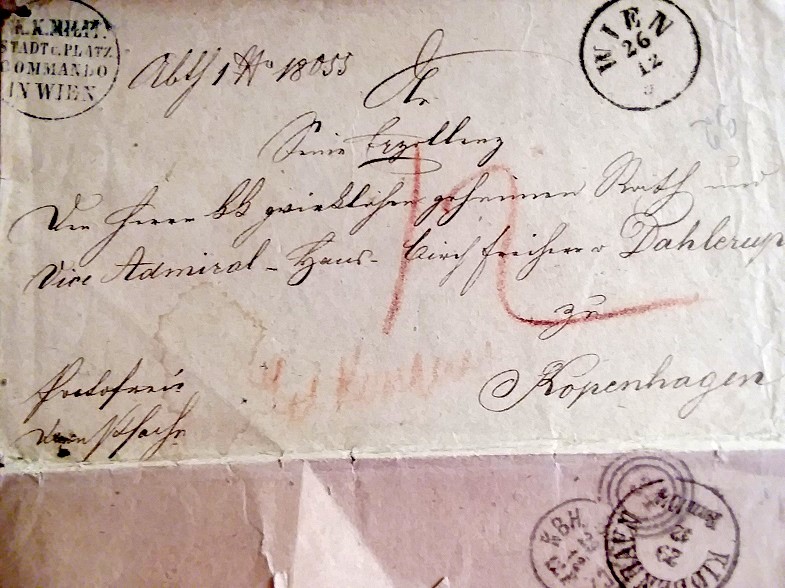|
The
|
THE BURGENLAND BUNCH NEWS - No. 323 September 30, 2021, © 2021 by The Burgenland Bunch All rights reserved. Permission to copy excerpts granted if credit is provided. Editor: Thomas Steichen (email: tj.steichen@comcast.net) BB Home Page: the-burgenland-bunch.org BB Newsletter Archives: BB Newsletter BB Facebook Page: TheBurgenlandBunchOFFICIAL Our 25th year! The Burgenland Bunch Newsletter is issued monthly online. The BB was founded in 1997 by Gerald Berghold, who died in August 2008. |
| Current Status Of The BB: * Members: 3081 * Surname Entries: 9107 * Query Board Entries: 5874 * Staff Members: 13 |
This newsletter concerns: 1) THE PRESIDENT'S CORNER 2) A CURIOUS LETTER 3) HISTORICAL BB NEWSLETTER ARTICLES: - BH&R-BASED RESEARCH (Extended) 4) ETHNIC EVENTS 5) BURGENLAND EMIGRANT OBITUARIES (courtesy of Bob Strauch) |
1) THE PRESIDENT'S CORNER (by Tom Steichen)  Well,
a booster shot for Covid is now a reality for those 65 and older and/or otherwise medically compromised. Of course, the
vaccine still remains available for those age 12 and up who have yet to take advantage of its benefits. Well,
a booster shot for Covid is now a reality for those 65 and older and/or otherwise medically compromised. Of course, the
vaccine still remains available for those age 12 and up who have yet to take advantage of its benefits. Looking at hospitalization data, it seems clear to me that there is a benefit, as the most recent data indicates that, for those with a Covid infection, the hospitalization rate for unvaccinated adults is now over 97 times greater than that of vaccinated adults. On top of that, the risk of a Covid infection is now 8 times greater among unvaccinated versus vaccinated adult, so the vaccine both helps avoid any infection and, if you still get infected, also protects you from a dangerous infection that could result in an expensive, lengthy hospitalization or even death. Given these odds, I'll be getting the booster as soon as possible... and I'll hope you do too! Another, rather disturbing, bit of Covid news is that the CDC reports a 12-fold increase in Covid cases among school-age children in Pennsylvania (where I live) compared to the same period a year ago. While they do not speculate about the cause, one must wonder if the new variants affect young people more than the original Covid (or if, instead, we are not as vigilant as we were a year ago). It is true that less than half of the eligible students in PA are currently vaccinated and, of course, none of the younger students are. Nonetheless, infections among this group are now over 25% of all cases in Pennsylvania, and that is scary! This month's bits and pieces (Article 1) revisits the Emilie Illitchmann story from articles I published in April and May of this year, but this time concentrates on her mother, Franziska. That is followed by a bit about the Burgenland State Parliament, who revisit two topics I wrote about recently: Covid and the A3 extension! From there, I also revisit the Kukmirn Translation List, which we recently discovered is "wrong" (quotes are used here because the translation is correct for a particular time period but that period is not the one we intended!). The final random bit is sort of a revisit too... or at least the ending of a revisit... FamilySearch announced that they have completed the digitization of all their microfilmed rolls of record images! ...and they are going to start on their microfiche collection now (a far smaller task!). Then we have our regular tidbit features: a monthly update on corona-virus happenings in Burgenland, the monthly BB Facebook report, book sales, a recipe and a cartoon-of the month. In Article 2, I present what I've titled A Curious Letter. However, as you'll see, I learned later that it is not a short letter, rather it is just an envelope... and old and very curious envelope! And it fascinated me enough that I've chosen to share it with you! The remaining articles are our standard sections: A Historical BB Newsletter article, Ethnic Events and Emigrant Obituaries. However, we have no emigrant obits this month so I've chosen to use that space for the obit of a US-born person, one indirectly associated with the Burgenland Bunch, Rudy Kresh. Franziska Illitchmann, Revisited: In BB Newsletters 319 (April) and 320 (May) of this year, I wrote about Emilie Illitchmann, born illegitimate to Franziska Illitchmann in 1874 in Vienna. Emilie eventually moved to Kukmirn and married Ferencz Ernst in 1901. After he died in 1906, she emigrated to the US with some of her children and married Joseph Schwartz in Allentown, PA, in 1907. She lived out her life in the US with Joseph, dying in 1956 in Emmaus, PA. I also had discovered that her mother Franziska was likely from the Moravian town of Herautz, now Heroltice, Štíty, Czechia, and I discovered a number of birth records there that might have been for "our" Franziska Illitchmann; however, I had too little information about Franziska to say which birth record was actually hers. My articles evidently interested Ingrid Schuster, an avid researcher and member of the BB Facebook page, as she recently spent time in the Wiener Landesarchiv to do further research on Emilie's mother Franziska. What she discovered was that Franziska had five more illegitimate children at the Vienna birthing facility (links to birth records provided), with Emilie being her youngest child. Ingrid also found additional information that confirms Franziska's origin in Herautz as well as the index page for the Herautz births that indicates multiple babies there were named Franziska Illitchmann. Unfortunately, like me, she did not find information that told us which was "our" Franziska.  Lastly,
I'll note that Ingrid copied me on a clip from a related document of a type I'd not seen before. As she did not include the
column headers, I was especially baffled, even though I could read some of the handwritten text. It did not help that there
were abbreviations, unclear letters and generally cryptic sub-entries within it. However, this is the document that makes it
clear that Franziska Illitchmann was from Herautz and seems to indicate that she was 35 years old at the time of the
document, however, the year of the document is not evident from what is written on the portion I received. What is clear is
that daughter Emilie, born 1874, is identified on it so the year must be 1874 or more recent. Assuming the year of the
document is 1874 and that I read the seeming age of Franziska correctly, the combination implies she was born in
1841, which may help discern which is the correct birth record for her in Herautz. For now, I await more information about
this document from Ingrid. Lastly,
I'll note that Ingrid copied me on a clip from a related document of a type I'd not seen before. As she did not include the
column headers, I was especially baffled, even though I could read some of the handwritten text. It did not help that there
were abbreviations, unclear letters and generally cryptic sub-entries within it. However, this is the document that makes it
clear that Franziska Illitchmann was from Herautz and seems to indicate that she was 35 years old at the time of the
document, however, the year of the document is not evident from what is written on the portion I received. What is clear is
that daughter Emilie, born 1874, is identified on it so the year must be 1874 or more recent. Assuming the year of the
document is 1874 and that I read the seeming age of Franziska correctly, the combination implies she was born in
1841, which may help discern which is the correct birth record for her in Herautz. For now, I await more information about
this document from Ingrid.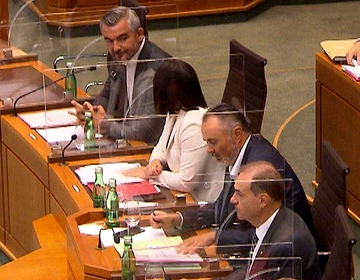 Burgenland
State Parliament Debates: The Burgenland State Parliament recently held its first meeting after their summer break
and it was "politics" as usual. A couple of topics I've discussed in this newsletter were on the agenda: Burgenland
State Parliament Debates: The Burgenland State Parliament recently held its first meeting after their summer break
and it was "politics" as usual. A couple of topics I've discussed in this newsletter were on the agenda:Covid and economic relief: The minority parties, ÖVP, FPÖ and Greens, denigrated the actions of the majority party, the SPÖ, because "Burgenland has taken just 14 measures - but the front runner Tyrol has taken 54 measures. In Burgenland 1.5 percent of the total budget was spent - in Tyrol it was as much as five percent." Alexander Petschnig, an FPÖ member of the most recent Burgenland government delegation to the US, referred to "the state government's lethargic approach to the Covid-19 crisis and how it was dealt with," calling it "incomprehensible." When the SPÖ defended the country's measures, the Greens accused the SPÖ of appropriation: “Any criticism of the SPÖ ... is commented on as if it were a criticism of Burgenland or the Burgenländers. This is an unparalleled appropriation of an entire country by one party." I'm not convinced the discussion in the parliament accomplished anything, but it truly was a demonstration of "politics as usual," an approach that spans continents and cultures! The A3 extension: It seems the recently rejected extension of the A3 highway to the Hungarian border was not quite dead... the FPÖ called for a referendum, which the ÖVP supported saying: "It is a balancing act for the public sector to decide between quality of life and well-developed roads." However, the SPÖ and Greens had enough votes to deny the request and to push through a formal amendment against the extension. So the discussion moved on to alternatives to "closing the gap" such as train stations and using bicycles, neither of which truly addressed the issue of excess automotive and truck thru-traffic on the local streets that the extension would have addressed. The arguments against the extension were always noise and air pollution (and saving a little agricultural land)... but I'm not convinced forcing the continuation of stop-and-go traffic on the local streets will yield less noise and air pollution, nor will doing so benefit the agricultural land those streets run through... but that's just my personal opinion. Kukmirn Translation List: We recently discovered that the 1850s-era house numbers (Konscription numbers) in Kukmirn were apparently replaced (renumbered) in the 1936-1947 era, meaning our Translation List for that village may provide an incorrect connection/correlation/translation of some or all old (pre-1936) house numbers to modern street and orientation numbers. Patrick Kovacs discovered the problem when examining a 1936 plat map of the area where some of his ancestors lived. Simply put, the numbers on the 1936 map (apparently the same as the 1850s era Konscription numbers) did not agree with the current Konscription numbers found on post-1947, modern plat maps and in other modern sources... nor with those used in our Translation List. We apparently tied our street/orientation numbers to these post-1947 numbers rather than the intended pre-1936 numbers. Of course, at the time we did that we did not know that there were two sets of Konscription numbers for the village, which is why the error occurred. You might ask why we intended to tie street/orientation numbers to the pre-1936 numbers... and the answer is: it is the pre-1936 numbers that are the same as the house numbers that appear in the available church and civil records, all of which are for pre-1921 years. So if you want to see which modern house your 1870s ancestors lived in, we must provide street/orientation number connections to the older set of house numbers, and we did not do that! The important question now is what are we going to do about this? Patrick has discovered the materials needed to generate a Translation List of the older Kukmirn house numbers to street and orientation numbers, and he expects to complete a new Translation List in the coming weeks. When that list is available, we will replace the current, "incorrect" Translation List with a three-part list that translates between the old Konscription numbers, the newer Konscription numbers, and the street/orientation numbers. Hopefully, we will be able to determine the exact year when the Konscription renumbering occurred. If not, we will try to make it clear that that there is fuzziness about the 1936-1947 period and will advise you to proceed cautiously, verifying as much as you can about which house number you have. Meanwhile, we apologize if we have misled anyone. Our "incorrect" Kukmirn Translation List has been online since 2015... if you used it to tie a pre-1947 house number to a modern street address, you will need to verify whether we led you to a wrong street address (I suspect we did). However, if you were working with a post-1947 house number, the list should have given you the right street address. Separate from all this is our House List for Kukmirn. That list ties the 1858 house number to its owner at that time, and that remains a correct connection. 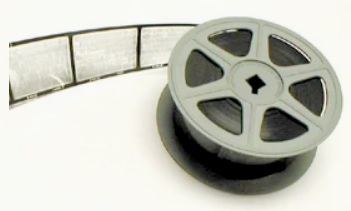 FamilySearch
Completes Digitization of Microfilm Collection: On September 21, FamilySearch announced that it had completed
the digitization of its 2.4 million rolls of microfilm. Over 200 countries and principalities and more than 100 languages
are represented in the digitized documents. FamilySearch
Completes Digitization of Microfilm Collection: On September 21, FamilySearch announced that it had completed
the digitization of its 2.4 million rolls of microfilm. Over 200 countries and principalities and more than 100 languages
are represented in the digitized documents. FamilySearch began microfilming in 1938 and, for many decades, duplicates of the original rolls could be ordered and viewed at one of FamilySearch’s family history centers worldwide. But, in 1998, FamilySearch purchased its first microfilm scanners and started the process of making microfilm obsolete, finally ending microfilm distribution in September 2017 when it began the transition to an all-digital online-access approach. Although the digitization project was expected to take over 50 years to complete, advances in technology helped shorten the timeline by nearly 30 years, with a big leap forward in 2006 when software and automated processes were developed by FamilySearch. The scanning that began with 5 employees. eventually involved 30 employees using 26 automated scanners, continuing even during the COVID-19 pandemic. As a next step, FamilySearch will begin digitizing the 335,000 microfiches in its collections. FamilySearch continues to capture images of original records, but only in digital form, bypassing the need to transfer the images from microfilm. Per other announcements, FamilySearch reported adding 13.9 million new records during the first 3 weeks of September, so that effort clearly continues at a significant rate!  Corona
Virus in Burgenland: As noted before, Austria lifted entry restrictions for travelers arriving from the United
States in June but proof of vaccination, proof of recovery from COVID-19 or a negative Covid-19 test result must be
presented upon entry into Austria. Corona
Virus in Burgenland: As noted before, Austria lifted entry restrictions for travelers arriving from the United
States in June but proof of vaccination, proof of recovery from COVID-19 or a negative Covid-19 test result must be
presented upon entry into Austria.The latest medical data indicates that Burgenland continues to increase its vaccination rate, with over 75% of the ~265,000 eligible citizens either fully or partially vaccinated (a corresponding percentage for the US is 55%). A third "booster" dose became available quite recently and the latest report, dated the 26th, indicates nearly 3,000 booster shots already administered. Active Covid cases across the province in recent days have numbered around 330, with less than 5% of those requiring hospitalization and under 1% requiring intensive care (the corresponding current hospitalization rate in the US is 8%, perhaps indicating the more serious nature of infections in a population with a lower vaccination rate). 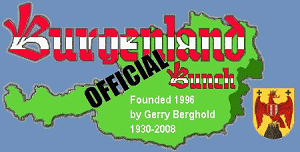 The
Facebook Bunch (from Vanessa Sandhu): The
Facebook Bunch (from Vanessa Sandhu):Greetings Burgenland Bunch! Here is a quick recap of what we’ve been up to this month in our Facebook group. We now have 1716 members, a gain of 16 since last month. Please join us if you haven’t done so! We always have a great time sharing the stories and traditions of our ancestors! facebook.com/groups/TheBurgenlandBunchOFFICIAL/ Member Martin Wolf shared updates related to his gathering held in Neuhaus am Klausenbach on September 5, 2021. A large number of Americans traveled to the event from New Britain, Connecticut. A wonderful time was had by all in attendance! I shared lots of photos and a video from the Coplay Sängerbund’s Oktoberfest, held on September 12, 2021. Approximately 400 people were in attendance, including a large number from our Facebook group! It was a beautiful afternoon and the Sängerbund did a fantastic job keeping our heritage alive. I was honored to carry the flag of Burgenland during the parade - it was a wonderful experience! Several members have added their kits to Ingrid Schuster’s “The Burgenland Bunch” Ancestor project on Gedmatch. 181 kits have now been registered. Several more members are in the process of adding theirs. Member Jackie Treiber shared documents relating to the Galovics family from Neumarkt im Tauchental. The documents contain marriages and may be relevant for anyone researching the Unger, Mattis, Konrath, Treiber, Muth, Kosarits, and Juran surnames. Member Tim Hermesdorf shared a document detailing the history of the Vaderland (later known as the Southland), a sailing ship that carried many of our Burgenland ancestors to their new home in America. Many excellent links were shared from Landesmuseum Burgenland this month. The museum focused on the early history of Burgenland. We learned some interesting facts about the Burgenland crest, the disintegration of the Habsburg monarchy in Burgenland, and the large numbers of Burgenland emigrants who made Chicago, Illinois, their new home. CONNECTIONS: Member Susan Fleck is looking for photos from the Redlschlag area from the late 1800’s- early 1900’s for a project she is working on related to her Fleck and Schmidt families. Member Luke Terry is looking for historical information related to his Gsellmann family from Göls. His great grandfather Georg was born there in 1912. If anyone has any information for Susan or Luke, please email me at HooftyRN@msn.com. I would be happy to pass the information on to them! We will close with some photos of the Coplay Sängerbund’s Oktoberfest. I hope that you are all staying safe and healthy! 
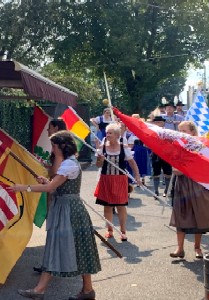  
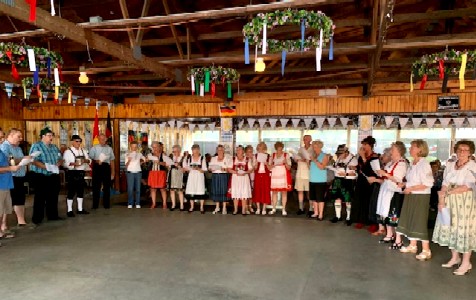 Take care! Vanessa  Update
for book "The Burgenländer Emigration to America": Here is this month's update on purchases of the English issue of
the 3rd edition of Dr. Walter Dujmovits' book "Die Amerika-Wanderung Der Burgenländer." Update
for book "The Burgenländer Emigration to America": Here is this month's update on purchases of the English issue of
the 3rd edition of Dr. Walter Dujmovits' book "Die Amerika-Wanderung Der Burgenländer."Current total sales are 1618 copies, as interested people purchased 3 more books during this past month. As always, the book remains available for online purchase at a list price of $7.41 (which is the production charge for the book, as we purposely choose not to make a profit so we can avoid dealing with the income tax consequences and so you can obtain the book at as low a cost as possible!), plus tax & shipping. See the BB homepage for a link to the information / ordering page and for information about current discounts (there is at least one discount on price or shipping available most of the time... if not, wait a few days and there will be one!). Getting the book and reading it is an excellent way to pass the time should the coronavirus impose yet another round of "house arrest" ...and even if not "arrested," it should still prove to be informative! Burgenland Recipes: Member Gus Maikish remembered some fantastic Burgenland recipes in an old issue of Gourmet Magazine. After some intrepid detective work he managed to locate the July 1987 issue on eBay, and we now have a number of recipes from the article, Gourmet Holidays: Austria's Burgenland. The article was written by Lillian Langseth-Christiansen with photographs by Ronny Jacques. This first one sounds really delicious!  Burri
Suppe (Pannonian Leek Soup) Burri
Suppe (Pannonian Leek Soup) (from Gus Maikish / Gourmet Magazine 1987) Ingredients: . 1 stick (1/2 cup, 8 Tbsp) plus 1 Tbsp unsalted butter, divided 6 Tbsp and 3 Tbsp (see below) . 6 Tbsp unsalted butter (see above) . 10 large or 12 medium leeks, split lengthwise, washed well, and sliced (about 10 cups) . 1/3 cup all-purpose flour . 4 cups brown stock or canned beef broth . 6 slices of Canadian bacon, chopped . 3 Tbsp unsalted butter (see above) . 4 slices of homemade-type white bread, crusts removed, and the bread cut into 1/2-inch square croutons . 1/4 cup heavy cream . 1 tsp paprika (preferably sweet Hungarian) . 1/2 tsp dried basil, crumbled . 1/2 tsp dried marjoram, crumbled . salt and pepper (as needed) . 3 Tbsp snipped fresh chives . 1/4 cup sour cream Preparation: In a large kettle cook the leeks in 6 tablespoons of butter, covered, over moderately low heat, stirring occasionally, until they are just tender. Add the flour, and cook the mixture, stirring, for 3 minutes. Stir in the stock, bring the mixture to a boil, stirring, and simmer it, covered, stirring occasionally, for 45 minutes. While the mixture is simmering, in a heavy skillet cook the bacon over moderate heat, stirring, until it is crisp and transfer it with a slotted spoon to paper towels to drain. Add the remaining 3 tablespoons of butter to the skillet, heat the fat until the foam subsides, and in it cook the bread, stirring, until it is golden brown. Transfer the croutons with a slotted spoon to paper towels to drain. Add to the kettle the cream, the paprika, the basil, the marjoram, and salt and pepper to taste, stirring. Divide the soup among 6 heated bowls, and serve it with the croutons, bacon, chives and sour cream. The croutons, bacon and chives can be added to the surface of the soup at the discretion of the chef and/or the diner, and a small dollop of sour cream can be added for additional flavor. Notes: Makes about 7 cups, serving 6.  Note:
Our recipes sortable list has links directly to the recipes or food-related articles published
in our past newsletters. You can access the list by clicking our recipe box (to the right). Thanks to the contributions of
our members over the years, we have quite a collection of Burgenland recipes, some with several variations. Note:
Our recipes sortable list has links directly to the recipes or food-related articles published
in our past newsletters. You can access the list by clicking our recipe box (to the right). Thanks to the contributions of
our members over the years, we have quite a collection of Burgenland recipes, some with several variations.However, we have now used up our unpublished recipes... thus this recipe section will be dormant whenever we have no recipe to publish. So, if you have a favorite family recipe, please consider sharing it with us. We will be happy to publish it. Our older relatives, sadly, aren't with us forever, so don't allow your favorite ethnic dish to be lost to future generations. You can send your recipe to BB Recipes Editor, Alan Varga. Thanks! Cartoon of the Month: 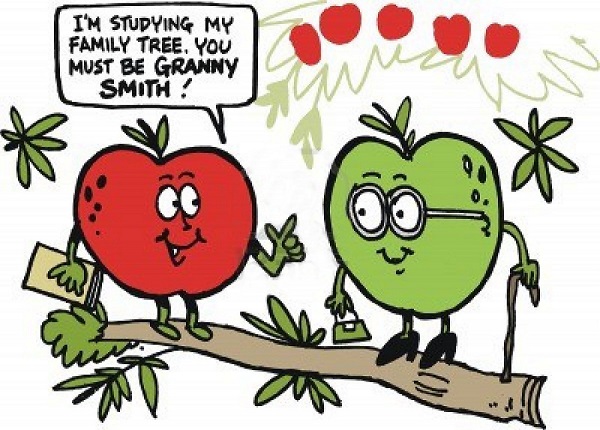 |
2) A CURIOUS LETTER Back in July, shortly before I took time away from the newsletter so my wife and I could travel back to our home turf, Minnesota, I received a short email with image attachments from Joy Minns, a BB member who always seems to come up with new and curious things! It turns out that that the subject of that email had little to do with Burgenland history or genealogy... but it is, nonetheless, an interesting Austro-Hungarian document; one which I'm sure you will find of some historical (and potentially educational) interest. So here it is... Joy writes: Hi Tom, As usual, my brain refuses to learn this script. This note belongs to a friend. The number of postmarks is odd. I can make out a few words but would love it if you could make out the rest. Thanks, Joy Joy's "this
script" referred to the old German "Kurrent" hand-script that often proves to be confounding to the uninitiated,
and much of "this script" covered the images she sent. I'll insert one image below (the others were mainly useful for
better showing the stamps that were partially cut off in this image). And since Joy lives in the US, I presume her friend does too, so: |
3) HISTORICAL BB NEWSLETTER ARTICLES Editor: This is part of our series designed to recycle interesting articles from the BB Newsletters of past years. The entry below, from 10 year ago, was an example of how to use our BH&R (Burgenländers Honored and Remembered) section as a catalyst for research into a family line you know little about. I'm reprinting the article because, despite the current availability of online, digital vital records for Burgenland, BH&R still remains an important way to get an initial idea of where a family line came from. I underlined the word "current" in my prior sentence because we were still using physical microfilmed vital records in 2011... online digital vital records would not start becoming available until 2017. So, all we had in "digital" format was the FamilySearch index (which, while useful, is filled with poorly-transcribed data) and the Ellis Island digital manifests. If you wanted more data, you had to order microfilms. If you read through the article below, you will see we limit our answer to these two non-microfilm sources. However, digital records are, in fact, now available... so I was able to easily extend that research and confirm (or not?) various statements. I will place my "extension" of the research at the end of the 2011 article... but I will also insert some corrections into the old article, placing those corrections in italics in double square brackets, [[ like this ]]. THE BURGENLAND BUNCH NEWS No. 213 September 30, 2011 BH&R-BASED RESEARCH In an editorial note to Article 3 above, I claimed that "...the BH&R pages are a vital resource for Burgenland genealogical research. The BH&R database ties together names (especially often-unknown maiden names) with their spouses, birthplaces and final resting places. Margaret Kaiser, one of the reviewers of new BB membership applications, often shares information from the BH&R pages with the new member." Below is an example where I used BH&R as a crucial link in assisting a correspondent. Heather Hunt of Findlay, Ohio, wrote: My name is Heather Hunt. My Great
Grandfather was David Schreiner. I do not know much about him other than he married Theresa Damweber and lived in Allentown.
I know that he came to the USA in the 1880's and was born in Szentgvtherd, Hungary (per birth certificate). [[ As should
be evident from comments below, David was born in the 1880s and the intended village was Szent Gotthárd. He came to the US
in 1907. ]] Can you tell me anything more about him? He had a son, my grandfather, John Schreiner who married Ruth
Stoneback Shup. Ruth and John had three children, Carol, Nancy and John. I am Nancy's daughter, Heather Newcomer Hunt. My
grandmother Ruth just died this spring and she did not really know much about that side of the family. Thank you! |
4) ETHNIC EVENTS LEHIGH VALLEY, PA Wednesday-Sunday, Sep.29-Oct.3: Oktoberfest at the Reading Liederkranz. Info: readingliederkranz.com Friday-Sunday, Oct.1-3: Oktoberfest at Steel Stacks in Bethlehem; Info: steelstacks.org/festivals/oktoberfest/ Friday-Sunday, Oct.3: The Steelworkers at the Coplay Sängerbund. Info: coplaysaengerbund.com Friday-Sunday, Oct.8-10: Oktoberfest at Steel Stacks in Bethlehem; Info: steelstacks.org/festivals/oktoberfest/ Sunday, Oct.10: The Jolly Bavarians at the Coplay Sängerbund. Info: coplaysaengerbund.com Friday, Oct.15: Maria & John at the Lancaster Liederkranz. Info: lancasterliederkranz.com Sunday, Oct.17: Weinlesefest (Grape Dance) at the Coplay Sängerbund. Music by the Emil Schanta Band. Info: coplaysaengerbund.com Sunday, Oct.17: MSC Oktoberfest at the Reading Liederkranz. Music by the Josef Kroboth Orchestra. Info: mscreading.org/product/oktoberfest-2021-registration-sponsorship/ Sunday, Oct.24: The Josef Kroboth Orchestra at the Coplay Sängerbund. Info: coplaysaengerbund.com Sunday, Oct.31: Maria & John at the Coplay Sängerbund. Info: coplaysaengerbund.com NEW BRITAIN, CT Friday-Sunday, 1-8 pm: Biergarten is open. Austrian Donau Club, 545 Arch Street. ST. LOUIS, MO (none) UPPER MIDWEST (none) |
5) BURGENLAND EMIGRANT OBITUARIES (none this month) Since we have no true emigrant obituaries to share this month, I'm going to use this place to post an obituary of someone who is likely well-known in the BB community, especially among the BB staff. 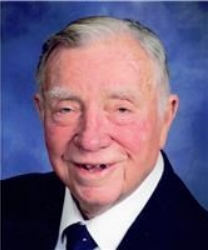 Our
friend, Rudy Kresh, passed away on September 19th. Rudy was the husband of Anna Kresh, a long-time BB
staffer, keeper of our BB Links page, and Vice President after the passing of Gerry Berghold. As such, Rudy was
pretty much an honorary BB staffer, sucked into our doing by Anna. Our
friend, Rudy Kresh, passed away on September 19th. Rudy was the husband of Anna Kresh, a long-time BB
staffer, keeper of our BB Links page, and Vice President after the passing of Gerry Berghold. As such, Rudy was
pretty much an honorary BB staffer, sucked into our doing by Anna.I wish to offer my condolences to Anna, but also my hope that she and her family can soon get over the pain of loss and remember the many good things about Rudy. He quickly became my friend and I will miss him too. Rudolph E. Kresh Jr.  Rudolph E. Kresh Jr., 91, of Butler,
passed away Sunday, Sept. 19, 2021, at home with family. Rudolph E. Kresh Jr., 91, of Butler,
passed away Sunday, Sept. 19, 2021, at home with family.Rudy was born July 15, 1930, in Bethlehem, Pa., and raised in Nazareth, Pa., and was the son of the late Rudolph E. Kresh Sr. and Irene Mae (Lear) Treon. He earned his own way through Moravian College, where he received a B.S. degree in business administration. He spent most of his career working for Burroughs Corp. in computer programming and systems analysis and design, including programmer management in the Pittsburgh and Trenton offices. He also worked for Lehigh Structural Steel Co. in Allentown, where he installed their first IBM system, and TRW-Fujitsu in Pittsburgh and Orlando, where he installed ATM systems on the eastern seaboard. Rudy was a tireless volunteer for worthy causes. He was a member of St. Andrew Catholic Church in All Saints Parish, where he served as an usher, parish council member and CYO leader. He was a member of the Knight of Columbus, and enjoyed passing out Tootsie rolls at Walmart to raise money, benefiting St. Anthony School and McGuire Home. He was also a Boy Scout leader and midget football coach. He managed horse shows for both 4-H and the Butler County Saddle Club, the latter for the benefit of the Easterseals Society, for which he earned the Brace for an Ace award by increasing donations ten-fold. He was also a past president of MORA Club, worked with Habitat for Humanity, and served on the board of Tanglewood Senior Center. He enjoyed family, travel, Civil War history, auto racing, golf and sports. He was a regular fan at school and sporting events whenever his children, grandchildren or other family members were participating. Rudy is survived by his wife of 67 years, Anna (Tanczos) Kresh, whom he married on July 17, 1954, in Sacred Heart Catholic Church in Bath, Pa.; his children, David (Cathi) Kresh of Washington, Pa., Irene (Jack) Rosati of McDonald, Pa., Daniel (Kim) Kresh of Butler and Teresa (Roger) McDowell of Butler; his grandchildren, James Rosati, Christina McElhinny, Megan McDowell, Patrick Kresh, Carrie Porr, Eric Hansen, Jared Hoffman and Carolyn Timko; and 10 great-grandchildren. He was preceded in death by his son, Leonard Kresh; and his grandson, Jacob Kresh. KRESH - Family and friends of Rudolph E. Kresh Jr., who died Sunday, Sept. 19, 2021, will be received from 5 to 8 p.m. Friday at Thompson-Miller Funeral Home, 124 E. North St., Butler. A Mass of Christian burial will be celebrated at 10 a.m. Saturday at All Saints Parish, St. Andrew Roman Catholic Church, 1660 N. Main St. Ext., Butler. Burial will be at St. Michael Cemetery. In lieu of flowers, donations can be made to the Knights of Columbus Bishop's Project at www.bishopsprojectkofc.org. Please visit www.thompson-miller.com. Published by Butler Eagle on Sep. 22, 2021 |
| END OF NEWSLETTER (Even good things must end!) |
|
Burgenland Bunch Newsletter, copyright © 2021 by The Burgenland Bunch |
 News
News